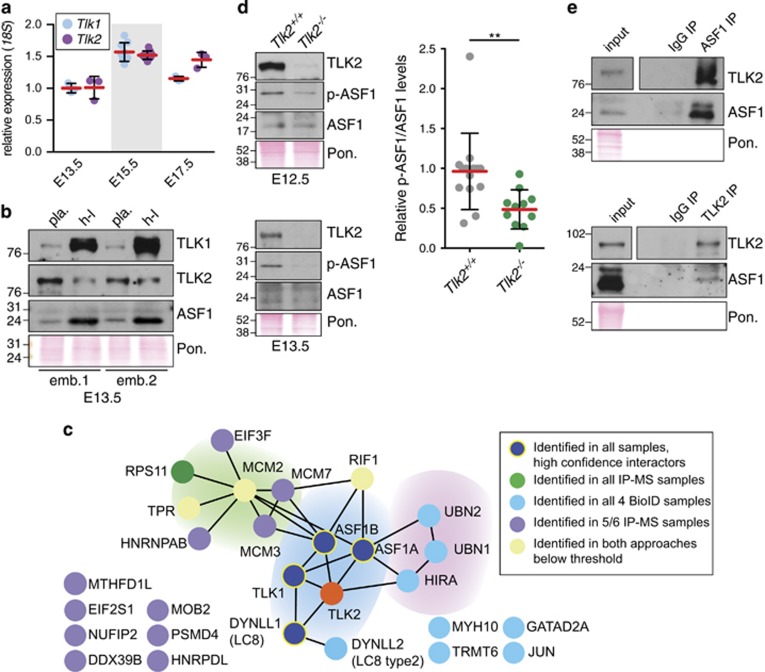Figure 5.
TLK2 interacts with ASF1 and influences its phosphorylation in the placenta. (a) Quantitative real-time PCR of Tlk1 and Tlk2 in wild-type placentas of the indicated age. Mean (red bars) and S.D. of triplicate samples is graphed (n=1, 3 and 1 for each age indicated). (b) Western blotting of TLK1, TLK2 and ASF1 in lysates from E13.5 placenta (Pon.=Ponceau red-stained membrane). TLK2 levels are similar in either tissue (placenta=Pla. and heart/fetal liver=h–l), while TLK1 levels are much higher in embryonic tissue relative to placenta. Samples from two littermate wild-type placentas are shown. Additional examples are shown in Supplementary Figure S4B. (c) Graphic depiction of the combined results from multiple proteomics approaches to identify TLK2-interacting proteins from HEK293T or AD293 cells (IP-MS and BioiD approaches and data are described in further detail in Supplementary Figure S5 and Supplementary Tables S1–S6). TLK1, ASF1a, ASF1b and DYNLL1 (LC8) are the only high confidence interacting proteins identified. LC8 does not appear to be a substrate of TLK2 (Supplementary Figures S5G and S5H). (d) Reduced ASF1-S166 phosphorylation (p-ASF1) in the E12.5 and E13.5 Tlk2−/− placentas. Western blotting of lysates for TLK2, ASF1 and p-ASF1 from littermates of the indicated age. In each case, blots shown are from the same membrane (Pon.=Ponceau red-stained membrane). Quantification of p-ASF1/ASF1 levels in multiple samples of the indicated genotype is shown in the right panel (additional Western blot analysis examples are shown in Supplementary Figure S6A). Statistical significance (P=0.0064) was determined using an unpaired t-test and the mean (red bars) and S.D. are indicated (n=14 and 11, respectively). (e) Co-IP of endogenous TLK2 and ASF1 from wild-type E13.5 placental lysates using antibodies for ASF1 (top panels) or TLK2 (bottom panels). (Pon.=Ponceau red-stained membrane). Additional examples are shown in Supplementary Figure S6B

